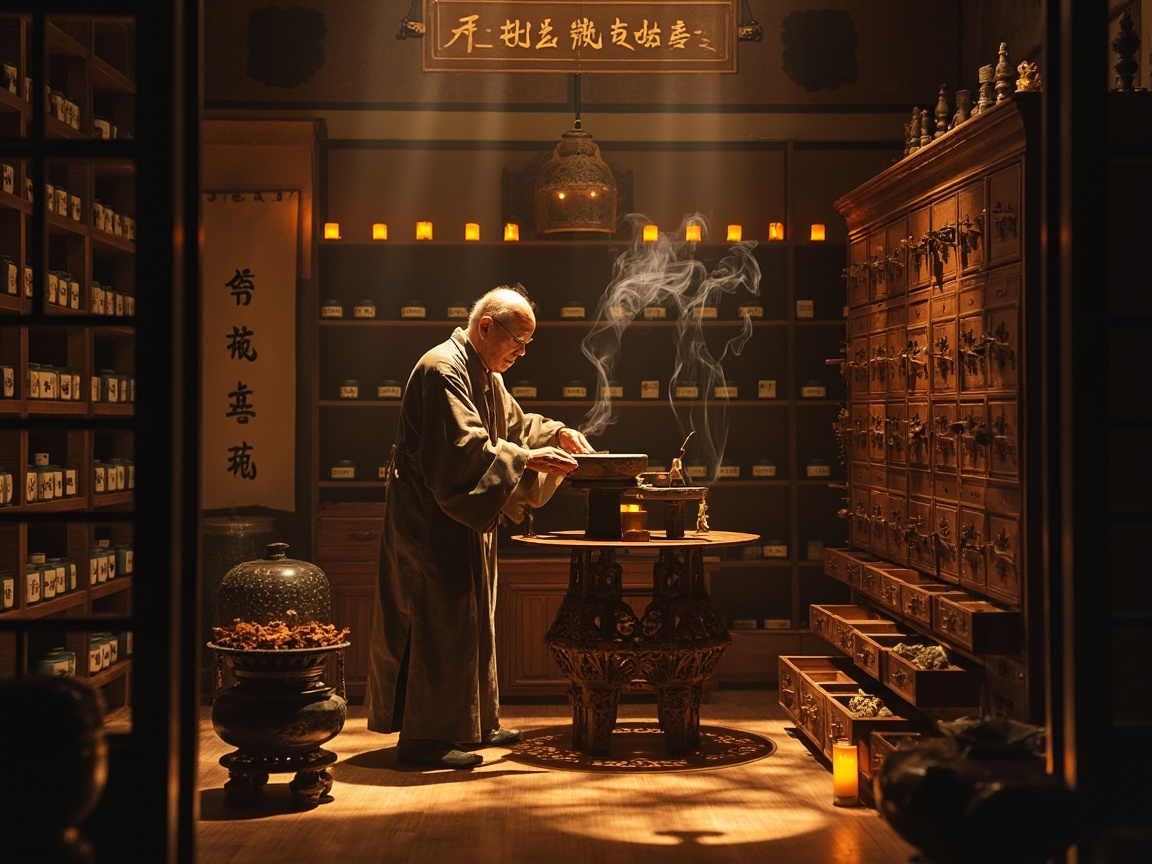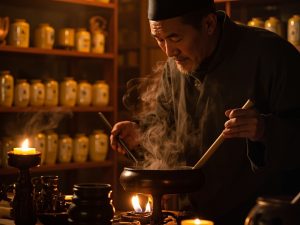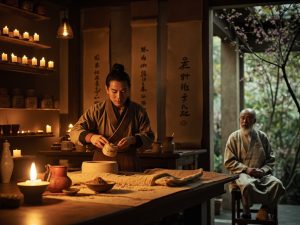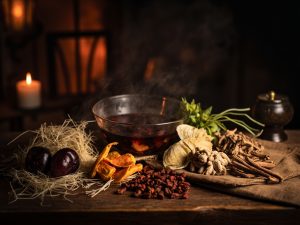Table of Contents
ToggleXiao Chai Hu Tang – Nan Kaiyang
Author: Nan Kaiyang Editor: Gu Yuxi Translator: Gu Yuxi
Original Text:
From Shang Han Lun (Treatise on Cold Damage), Clause 96: For cold damage of five or six days, complicated by zhong feng (wind stroke), with alternating chills and fever, fullness and distress in the chest and hypochondria, loss of desire to eat or speak, vexation and desire to vomit; or vexation in the chest without vomiting, or thirst, or abdominal pain, or hardness and oppression below the hypochondria; or palpitations below the heart, difficulty with urination. Or no thirst, slight fever, or coughing; Xiao Chai Hu Tang is indicated.
Appendix:
The above seven ingredients, with one dou and two sheng (approximately 12 liters) of water, are boiled to yield six sheng (approximately 6 liters). Remove the dregs, then re-boil to yield three sheng (approximately 3 liters). Take one sheng (approximately 1 liter) warm, three times a day.
- If there is vexation in the chest without vomiting, remove Ban Xia (Pinellia) and Ren Shen (Ginseng), add one mei (piece) of Gua Lou Shi (Trichosanthes Fruit).
- If there is thirst, remove Ban Xia, add Ren Shen, combining with the previous (ingredients) to make four and a half liang (approximately 135g) of Gua Lou Gen (Trichosanthes Root).
- If there is abdominal pain, remove Huang Qin (Scutellaria), add three liang (approximately 90g) of Shao Yao (Peony Root).
- If there is hardness and oppression below the hypochondria, remove Da Zao (Jujube), add four liang (approximately 120g) of Mu Li (Oyster Shell).
- If there are palpitations below the heart and difficulty with urination, remove Huang Qin, add four liang (approximately 120g) of Fu Ling (Poria).
- If there is no thirst and slight fever externally, remove Ren Shen, add three liang (approximately 90g) of Gui Zhi (Cinnamon Twig). Cover warmly to induce slight sweating for recovery.
- If there is coughing, remove Ren Shen, Da Zao, and Sheng Jiang (Fresh Ginger), add half a sheng (approximately 0.5 liters) of Wu Wei Zi (Schisandra Berry) and two liang (approximately 60g) of Gan Jiang (Dried Ginger).
Dosage of Chai Hu (Experiential Dosage):
- 16-24g: For harmonizing Shaoyang, primarily to clear heat.
- 10-15g: For soothing the Liver and resolving stagnation.
- 5-8g: For lifting Middle Yang.
Location of Disease and Formula Principles:
Xiao Chai Hu Tang consists of Chai Hu, Huang Qin, Ban Xia, Ren Shen, Gan Cao (Licorice), Hong Zao (Jujube), and Sheng Jiang. In six-channel differentiation, the pathogenic evil has transitioned from Taiyang to Yangming, then to Shaoyang, or has not yet reached Yangming but has reached Shaoyang, or Taiyang, Yangming, and Shaoyang are all present. Mr. Hu Xishu believes it belongs to a half-exterior, half-interior syndrome, where the person is extremely deficient, the cou li (space between skin and muscles) is open, and heat evil repeatedly invades the stomach qi, leading to depressed heat in the interior, hence vexation and vomiting. The righteous qi and evil qi contend in Shaoyang, causing alternating chills and fever. The accumulation of evil qi leads to fullness and distress in the chest and hypochondria. This formula addresses both supplementation and purging, with dispelling evil as its fundamental principle. It achieves transformation of Shaoyang fire, dryness transformation of Yangming, and simultaneously resolves superficial heat of Taiyang. When the evil is removed, the righteous qi is stabilized. Thus, Clause 104 states: “Take Xiao Chai Hu Tang to resolve the exterior.” The Shaoyang level encompasses a broad range, including Yangming (the six fu organs are also within its scope) and the Taiyang exterior. When the evil is dispelled and the accumulation resolved, the Gallbladder fu and momo (membrane source) can recover, leading to smooth circulation of Qi, Blood, and body fluids.
Herbal Pairings:
I. Chai Hu and Huang Qin:
Chai Hu and Huang Qin are paired to clear and regulate the depressed heat of the three Yang channels. Liu Duzhou believed that when studying the properties of herbs in the Shang Han Lun, one should primarily refer to Shen Nong Ben Cao Jing (The Divine Farmer’s Materia Medica). Ben Cao Jing records Chai Hu as bitter and neutral. It primarily treats the heart and abdomen; it removes congested qi in the intestines and stomach, food accumulations, and cold-heat evils (based on the compiler’s research, Chai Hu from Inner Mongolia most closely matches the records in Ben Cao Jing).
Therefore, the following three understandings of its medicinal properties can be inferred:
1.Opens stagnation and promotes qi circulation, soothes the Liver and benefits the Gallbladder, facilitates the six fu organs, promotes renewal, and regulates the ascending, descending, exiting, and entering of qi dynamic.
2.Can reach wood stagnation and vent fire stagnation.
3.Possesses unique functions of clearing heat and reducing fever, applicable to both exogenous conditions and various internal injury miscellaneous diseases. It can treat Liver and Gallbladder diseases and is also widely used for diseases of other organs.
II. Ban Xia, Sheng Jiang, Zhi Gan Cao, Da Zao:
Ban Xia (Pinellia) is determined by the vomiting condition. Zhi Gan Cao (Prepared Licorice), Sheng Jiang (Fresh Ginger), and Da Zao (Jujube) enter the Spleen, preventing the condition from developing into Taiyin Spleen dampness with abdominal pain and diarrhea.
III. Ren Shen (Ginseng):
As the saying goes, the marvel of Xiao Chai Hu Tang lies in the great tonification of Stomach Qi by Ren Shen. Lei Ju Fang (Categorized Prescriptions) records that Ren Shen specifically treats stomach deficiency syndromes with epigastric glomus and distention, while its tonic effects on other zangfu are slight. Observing Zhongjing’s use of formulas, Ren Shen is not used when there is no epigastric glomus or distention. Clinical practice indeed shows its efficacy in descending qi, harmonizing rebellious qi, and greatly tonifying Stomach Qi. Currently, Dang Shen (Codonopsis) is often used as a substitute. The conventional clinical dosage is 10-15g, and for children, it’s generally a fraction of the adult dosage.
Disclaimer:
The experiences and insights shared above represent the author’s personal usage and understanding, and are provided for reference only as part of academic exchange. Please do not blindly replicate or apply them; any consequences arising from such actions are solely your responsibility. As individual constitutions vary, medication should be tailored accordingly. It is advisable to use such treatments under the guidance of a qualified physician. If you have additional experiences to share, comments and submissions are welcome.
If you appreciate my article, please give it a like.
If you are a generous and affluent individual, please consider making a donation!
Your recognition is my greatest motivation to continue writing—thank you very much!
USD Donation Button —
A RMB donation button is available below.
 微信赞赏
微信赞赏 支付宝赞赏
支付宝赞赏




